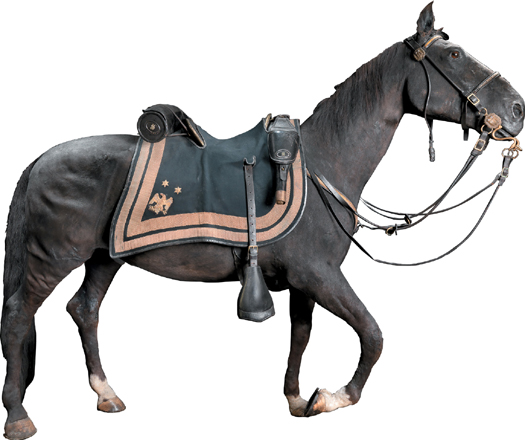 KG
KGIN AUGUST 1864 PHILIP SHERIDAN (1831–1888) WAS given command of all Union forces in the Shenandoah Valley. Ulysses Grant gave him orders to secure and strip bare that fertile corridor, which served as Virginia’s breadbasket and was used by Confederates to invade the North. After defeating Jubal Early’s forces at Winchester and Fisher’s Hill in September, Sheridan began burning farms and seizing or destroying livestock. On October 19 Early struck back, surprising Sheridan’s troops in camp at Cedar Creek while he was fifteen miles away at Winchester. Informed of the attack, Sheridan hurried to the front on his black Morgan horse, Rienzi, and arrived in time to rally his men and repulse the Confederates. Rienzi was renamed Winchester after the battle and honored in verse along with his owner by Thomas Buchanan Read: “Hurrah! Hurrah for Sheridan! / Hurrah! Hurrah for horse and man!”
Read’s poem, and a painting he composed on the same subject (inset), helped make Winchester famous. When the horse died in 1878, Sheridan had him preserved and installed at a military museum on Governor’s Island in New York. In June 1922 Winchester was transferred to the Smithsonian to reside at its National Museum in Washington, D.C. Among those who attended a ceremony on Governor’s Island to bid Winchester good-bye were elderly Union veterans, some of whom had probably seen him alive and kicking fifty-eight years earlier.  KG
KG

HORSE AND MAN Philip Sheridan and Winchester posed in New Orleans for this 1871 painting, Sheridan’s Ride, by Thomas Buchanan Read, who composed a famous poem with the same title.

WELL-PRESERVED Pictured in Washington, D.C. (FIRST IMAGE), while he was still very much alive, Winchester stood sixteen hands tall. He appears (SECOND IMAGE) in full tack—blanket, saddle, bridle, and martingale—as preserved at the National Museum of American History.